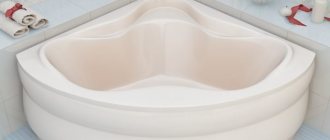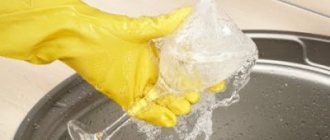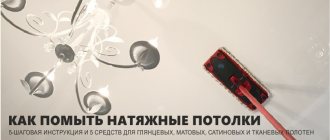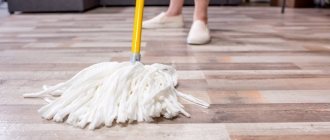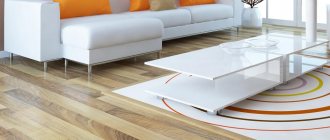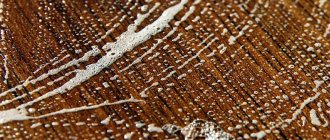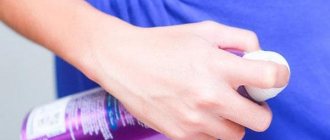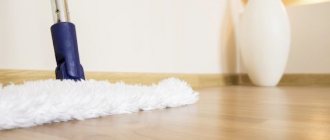Parquet board is a rather expensive flooring material, however, many people choose it for their home. This is due to environmental friendliness and long service life. In addition, in terms of design, there is no special framework for imagination.
This is interesting : parquet goes well with other materials and has a wide range of colors depending on the wood used.
But over time, the parquet does undergo changes - scratches remain from periodically moved furniture and irregular or improper care takes its toll.
In this article you will learn how to properly wash parquet so that it lasts as long as possible. The video will help you understand the process in more detail.
Tools for caring for wood flooring
Before you think about how to clean your parquet floors, be prepared for the fact that the floor covering may change appearance for reasons unrelated to your actions. Depending on the seasons, the board may “behave” differently.
For example, in winter, the dies begin to shrink, resulting in thin gaps between them. This is associated with the heating season and the inclusion of radiators in apartments. There is no need to worry too much about this; in most cases, with a change in humidity, after a couple of months, everything will return to normal. If you want to prevent the process, stock up on a humidifier.
But in summer the picture is exactly the opposite, especially if the year turned out to be rainy. The humidity in most rooms increases, and the parquet at the joints begins to bulge, “simulating” the effect of a flooded floor. To avoid this, you should take care in advance, even at the time of laying the board, and make it according to the principle of free flooring (without glue). As a last resort, ventilate the rooms more often to at least somehow adjust the balance.
Depending on what exactly you are going to do, the tools will vary:
- To apply specialized oil to give it its former shine, you will need a brush, roller or rubber spatula.
- The situation with washing is simpler - just arm yourself with a mop and a soft cloth that absorbs liquids well.
You can also find special brushes with replaceable soft-bristle attachments on sale. These are also suitable for laminate flooring.
Dry cleaning
Parquet flooring should be cleaned without any noticeable stains, without resorting to detergents. This type of cleaning should be carried out as often and regularly as possible. This is done with a regular mop with a soft attachment, which collects particles of debris and accumulated dust.
You can also resort to using a vacuum cleaner. Some manufacturers equip devices with special attachments. The most common brand is Karcher. The price tag for such a unit is quite significant, however, if you want to preserve the coating for a long time, this is the right investment.
How to properly wash parquet
Is it possible to wash parquet flooring without the fear that you will then have to do repairs or restoration? This is a fairly correct question that is worth asking when you have just laid a wooden floor. After all, if we take into account the above-described “whims” of the board, then there is a high probability of damage to the surface saturated with excess moisture.
Important : wet general cleaning is necessary - human health depends on the cleanliness of the room.
Here are a few nuances that will give you an overall picture of how to wash a parquet floor correctly:
- Choose a fine-pile cloth for cleaning. Microfiber or flannel are excellent for these purposes.
- Do not use abrasive cleaning products under any circumstances. Avoid pastes and powders.
- Even for local stains, do not use either hard brushes or scrapers.
- Use only special parquet cleaners for cleaning. Experiments with detergents for dishes, windows, and others are contraindicated.
- Do not scrub the floor with force.
- Carry out wet cleaning of stains immediately after they appear, without putting them aside.
We wash linoleum after repair
Using the means listed above, linoleum can also be washed. It is better to exclude kerosene - not all types of coating can tolerate it. You cannot use gasoline or ammonia - not all types of linoleum are friendly with them either. These solvents, along with dirt, can also dissolve the protective coating, so we don’t take risks.
To clean linoleum after repair, you need a lot of rags
But you can add laundry soap and turpentine to the list. It is better not to use more aggressive means.
How to remove stains
The spots have a different nature, and each type has its own method. Here are the most common ones, which tell you how to clean a parquet floor depending on the type of contamination.
Street dirt
The phenomenon is quite common. Especially during bad weather. Dirt systematically gets onto the parquet surface from the soles of shoes. It is recommended to get rid of it immediately, because sand can scratch the floor.
Additional stress on the tree is exerted by the reagents used to cover roads in winter - they are actively absorbed into the material and leave whitish stains. If you encounter a similar problem, the first thing to do is vacuum. And then wipe with a lint-free damp mop.
Oily stains
Cleaning a parquet floor with greasy stains is a more difficult task. There are several methods, both using professional and folk remedies.
- Store-bought drugs are worth purchasing if you are not trying to save money. The most common ones include: Aqua Sport Wood Floor Cleaner, Mellerud, Pufas Glutoclean, Adesiv Detpro.
- Adsorbing powders such as talc and magnesia will also help in the fight against fat. They need to be sprinkled on the problem area, covered with five layers of gauze and heated with an iron. An alternative version could be tooth powder.
- Fat fighters include vinegar and clay. Every housewife has the first one, but for the second remedy you will have to go to the pharmacy. The two components are diluted to a mushy consistency and applied to the area with the stain. Leave it in this state for 24 hours, then wipe it with a cloth and wipe it dry.
Advice : if you have the opportunity to choose a product from the manufacturer that made your parquet, choose it. This will guarantee a perfect result.
Urine stains
This question is relevant for pet lovers. And swelling of the parquet is not the only problem in this case. The tree actively absorbs the “fragrant” liquid, the amber of which subsequently hovers throughout the room.
If you notice a puddle, hurry to get a rag. Rubbing the stain is not recommended so as not to increase the volume of the problem. It is best to blot it with napkins.
Using similar manipulations, wash the marked area with soapy water. If the aroma is not eliminated, use vinegar - this is the most affordable odor neutralizer. It must be diluted with water in a ratio of 1:3. To achieve the final result, it is recommended to spray the surface with a solution of 200 ml of water, 100 ml of peroxide and half a teaspoon of dish soap.
Chewing gum stains
With chewing gum the situation is the same as with traces from a wax candle. You can cover the damaged area with damp, cold newspaper for a while; however, in this case, it is worth considering that keeping the paper wet for a long time can cause the wood to swell. It is better to use ice cubes placed in a plastic bag - under the influence of sub-zero temperatures, chewing gum loses its sticky properties.
Blood stains
Blood has always been difficult to remove. In order to deal with it, you will need hydrogen peroxide and a couple of drops of ammonia. If you have bleach, you can use it.
Ink stains
This phenomenon is mostly common in offices when printer cartridges are shaken inappropriately. To get rid of it, wipe the area with either detergent or vinegar.
Tar or tar stains
To remove contaminants of this origin, you can go in several ways:
- Use turpentine. They need to blot the cotton pad and wipe the problem area without applying pressure.
- A more accessible product is nail polish remover, which women almost always have.
Fruit stains
Contamination from berries and fruits can be easily removed with a soap solution or oxalic acid.
Folk remedies for parquet floors
Grease stains on parquet need to be sprinkled with starch or talcum powder so that the grease is absorbed.
You can wash parquet floors and remove different types of stains from it using home remedies. They are cheaper and more accessible than ready-made chemicals.
A few simple recipes:
- White clay . Will restore shine and newness to the coating. The clay is mixed with water until a thick paste is obtained. The mixture is spread on the floor surface and left for some time. After this, it is carefully removed with warm water.
- Starch . It will help remove greasy stains from parquet and other stubborn stains. The powder is poured onto the oil trail, a napkin is placed on top and ironed.
- Ammonia . A universal product that will efficiently remove stains from tea, coffee, and blood. It will restore shine to the parquet, remove scratches, and make the floor smooth.
You can eliminate black streaks from shoes without any chemicals, using nylon fabric. So don't throw away your old tights and stockings - they may come in handy for cleaning.
What to rub until shiny
In order for the parquet board to shine, it is treated with special means. Rubbing allows the floor covering to maintain a presentable appearance for a long time.
Cleaning detergents from the store
On the shelves you can find a lot of offers for caring for parquet boards, which are selected depending on the desired result. Some of them are universal cleaners not only for wooden but also other surfaces. Others perform deep processing and have a nutritional effect on the material. Still others allow you to get rid of the remnants of the previous coating layer during cleaning.
Among these are:
- Soap Oil;
- Idronet;
- Parquetpro.
What is
The first floors, finished with beautifully selected wooden planks, appeared in Europe in the 13th and 14th centuries. This cladding was made from different types of wood, and wood of different colors and textures was used to create patterns and ornaments on the floor. The individual parquet floors were attached to each other using special grooves.
Modern parquet has different structures and special types. The floor still requires separate boards, but mosaics, panels, and parquet boards are especially convenient for assembly and decoration.
All types of parquet differ in their natural composition. But installation methods, wear resistance and durability vary depending on the type, number of joints and layers.
Piece
Block parquet consists of individual boards with grooves and tenons for connection. They allow you to assemble the overall floor structure from a single piece of fabric. The size of the parts is 50x7.5cm, thickness 1.5-2.2cm.
This parquet is durable, suitable for different models and easy to repair.
Mosaic
A type of mosaic, or composition, consists of shields (side size - 40 or 60 centimeters), with the help of which exquisite patterns are assembled. The boards differ in the type of edges and options for attaching to each other. Under this type of parquet you can make an insulating layer on the floor.
Shield
A two-layer parquet consisting of a wood-fiber or plank covering and a decorative surface of small hardwood planks. The shield has significant dimensions, sometimes up to 80x80 centimeters.
Protective and decorative compositions from the store
Maintenance is not limited to washing the floors - it is regularly recommended to cover the parquet with special substances that extend the service life of the floor.
Parquet wax
This type of surface treatment product makes it possible to extremely quickly and effectively “seal” various scratches on the board, allowing you to restore not the entire surface, but only the necessary places, without leaving visible boundaries.
Important : the product does not interfere with air circulation and is highly waterproof.
There are several categories of parquet wax:
- Liquid. The advantages include the absence of the need for preliminary preparation of the substance, as well as the ability to treat areas that are difficult to access.
- Solid. Allows you to adjust the shade of the surface depending on the amount of introduced water required to obtain the desired consistency.
- Pasty. Easiest to use. To apply it, just use a spatula.
This is interesting : there are also types of wax that allow you to change or emphasize the shade: transparent, darkening, brightening.
Varnish
Varnish coating has a sufficient number of disadvantages:
- sensitive to temperature changes;
- is subject to mechanical stress, so special pads should be attached under the furniture legs;
- is not a “breathable” coating;
- quite a labor-intensive application procedure.
However, as opposed to the disadvantages, one can note the long-term period of operation.
Oil
If you choose oil to protect the surface, then it’s worth considering that you won’t be able to change your decision later. The varnish will not adhere to the surface treated with this composition. The disadvantages include the fact that such a floor is more susceptible to contamination, and as a result, requires more frequent maintenance.
Advantages of parquet oil:
- environmental friendliness;
- the ability to pass air;
- increasing the strength of the board;
- giving the coating a texture more pleasant to the touch;
- compatibility with “warm” floors;
- no aggressive odor;
- democracy of repair.
Polish
Purchased polishes are a finishing layer that is applied to the parquet - they give the coating even more shine. They differ in the type of surface: there are both matte and glossy, as well as in the method of application (for manual and machine processing).
If you single out certain brands, then EMSAL Glitter and MELLERUD are considered the most affordable in price. It is also recommended to use the German-made product Dr. Schutz.
Rules of care
There are several conditions that must be unconditionally fulfilled:
- Do not perform wet cleaning frequently. Washing parquet floors every day will not lead to anything good.
- Use devices with delicate surfaces.
- Choose cleaning products carefully and carefully depending on the type of parquet.
- If scratches appear, repair the defects immediately. They not only spoil the visual appearance of the interior, but also contribute to greater absorption of moisture into the wood.
- Renew the coating regularly.
- Try to balance the microclimate of the room.
Main causes of pollution
A number of reasons have a negative impact on the condition of parquet. Ordinary dirt is absorbed into the wood, penetrates into the cracks, disrupts the structure and spoils the appearance.
Moisture
Wood absorbs moisture from the air and liquids spilled on the floor. Because of this, spots appear and color changes. Water attracts other contaminants - dust, debris.
Pets
Ubiquitous animals scratch the parquet with their claws, drag fatty food and favorite toys across the floor. The most ill-mannered ones may urinate on the floor. The damage caused to parquet by pets is usually the most significant.
Furniture items
Heavy furniture presses down on wooden parquet, and dirt accumulates in the dents, which is difficult to remove. There are also traces on the floor from moving furniture, chairs on wheels, rocking chairs.
Shoes
Shoes with heels, as well as with soles that leave marks due to poor quality paint, contribute to the contamination of parquet floors. Wet things, bags, and umbrellas thrown on the floor also stain the parquet flooring. Moisture combined with dirt is detrimental to parquet.
How to update parquet at home
If at one time you did not pay special attention to the floor, and it has become quite worn out, and the solution to the problem is only possible through restoration, we suggest that you get acquainted with several radical methods. They will help restore your flooring to its former beauty.
Coloring
- The first thing you need to do is determine for yourself what color you want the floor to be. You can choose the same as the previous one or radically change the color scheme. The main thing is that the shade fits into the design of the room.
- Choose a paint that is a shade darker. This condition will allow you to achieve better results. Lighter shades will give you quite a challenge.
- Afterwards, thoroughly wash the damaged parquet. Debris particles will roll off when applying paint, resulting in a floor that is far from smooth.
- Arm yourself with knee pads, gloves and a dry cloth, which you may need if necessary to remove defects.
- Paint the floor with the windows open so as not to start the process of intoxication of the body with caustic fumes.
- When the paint is dry, coat with varnish, wax or oil and polish well.
Grinding
This is a rather labor-intensive process, because it requires preliminary preparation - scraping the parquet floor. This is done using a special machine that “cuts off” the top layer. If you are sure that the parquet has not been subjected to such execution before, you can safely operate the device. In the future, it is worth considering that a one and a half centimeter board is restored using this method a maximum of five times.
If you couldn’t get an automatic scraper, then buy a manual one. Use it to remove the top worn layer from the center of the room to the corners, walking along the wood grain.
And then start sanding the parquet. In construction stores you can also purchase a special “grater” to which sandpaper is attached.
putty
If gaps have formed between the lamellas, then it is quite possible to use putty that matches the color scheme. Add pigment if necessary.
- Before applying it (this is done with a spatula in a circular motion), you should get rid of debris. Also, after completing the manipulations, try to prevent dust from entering.
- After application, “scrape” the remaining putty from the surface of the coating.
Important : consider the properties of parquet. If it was originally varnished, give preference to a solvent-based putty; For oil or wax, an aqueous composition is quite suitable.
Toning
You can renew the parquet by giving it the appearance of expensive species or by artificially aging it, which can be done with tinting. True, there are several pitfalls that you can avoid by following this algorithm:
- mandatory high-quality scraping;
- sanding with fine abrasive sandpaper;
- identifying and correcting deficiencies.
Important : remember that when tinting old parquet, all defects become noticeable, so carry out the preparatory work conscientiously. Also take into account the “capriciousness” of some types of wood. This mainly applies to pine and beech.
Finish coating
But it’s up to you to decide how to complete the floor reconstruction. Oil, varnish or wax is a matter of taste. Here are some tips that can help you choose a “finish”:
- Gloss is great for spacious rooms such as a living room, dining room, creative or work area. On such a floor, not only light will be clearly reflected, but dust will also appear.
- But matte finishes are good for the intimate atmosphere of bedrooms.
Take care of your home correctly and in a timely manner, and it will “thank you” with comfort and a pleasant atmosphere. Good luck!
Basics of proper cleaning
What care products are best to use and how to clean parquet without sanding. It should be noted that even a high-quality approach cannot save you if the correct parquet cleaning conditions are not met. Namely:
- To prevent the wooden floor from deforming, it is necessary to maintain the microclimate in the room.
- The air temperature should be from +18 to -25°C.
- Atmospheric humidity 40-55%.
- When the heating is on, humidification is required.
- During the rainy seasons - dry.
Wood is a material that quickly absorbs moisture. This can lead to the formation of mold and harmful bacteria.
It is not recommended to check the strength of parquet that has been freshly laid by a master. After the varnish composition has gained strength and 4-5 days have passed for the floor to shrink, you can begin operation. Please note that during installation, walking on parquet tiles is prohibited. It is not recommended to ventilate the room. This can cause surface “bubbling”. In the first 2 weeks you must follow some rules:
- walk carefully on the floor;
- neither run nor jump;
- when installing furniture, it is better to lay fiberboard;
- When cleaning parquet, do not apply it in water;
- the surface must not be covered with anything. Carpet materials are especially prohibited.
Otherwise, dark spots will appear after a few days.
For furniture legs it is necessary to use pads. They can be felt or rubberized. If there are wheels, they should be coated with silicone. Daily cleaning of parquet is recommended with dry material. If there is minor dirt, cleaning with a damp cloth is recommended. Dust - a vacuum cleaner with a special attachment or brush is recommended.
You can clean parquet at home using special cleaning products. They are called cleaners. But still, you should not wet the floor too much. It is important to wring out the cloth well so that the floor dries faster and does not absorb excess moisture.
Maintenance measures for varnished surfaces
Lacquered flooring is preferable for rooms. It also makes parquet floors easier to clean. However, the coating should then be renewed.
Before you remove the top layer of the flooring yourself, you need to master the imitation of seams, as well as putty. From the beginning you should putty. To do this, you can buy a ready-made mixture in special stores. Or you can cook it yourself. Take sawdust and add varnish for coating. Next, you need to seal the seams yourself. You need to wait until the grout dries slightly. Run an awl along the joints along a ruler.
How to clean parquet without sanding? It is advisable to wash it weekly, no more. But only with the use of special cleaning products. Using components such as:
- Spray - apply to dirt, then wipe with a microfiber cloth.
- Specialist. compositions - soak a rag in them, wash, wring out, and dry.
When cleaning varnished floors, you cannot use water above 50°C, chlorinated agents, or powder.
